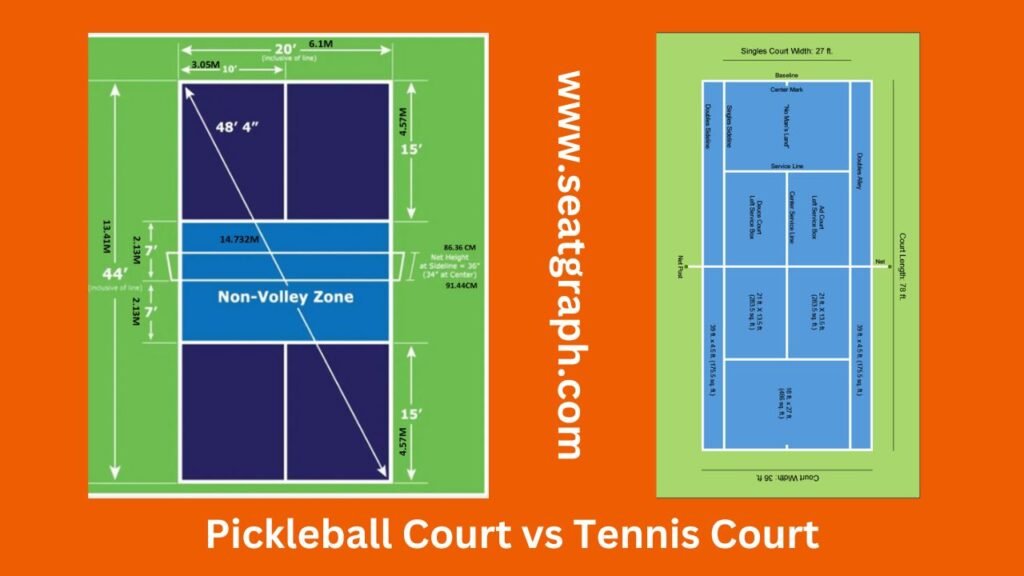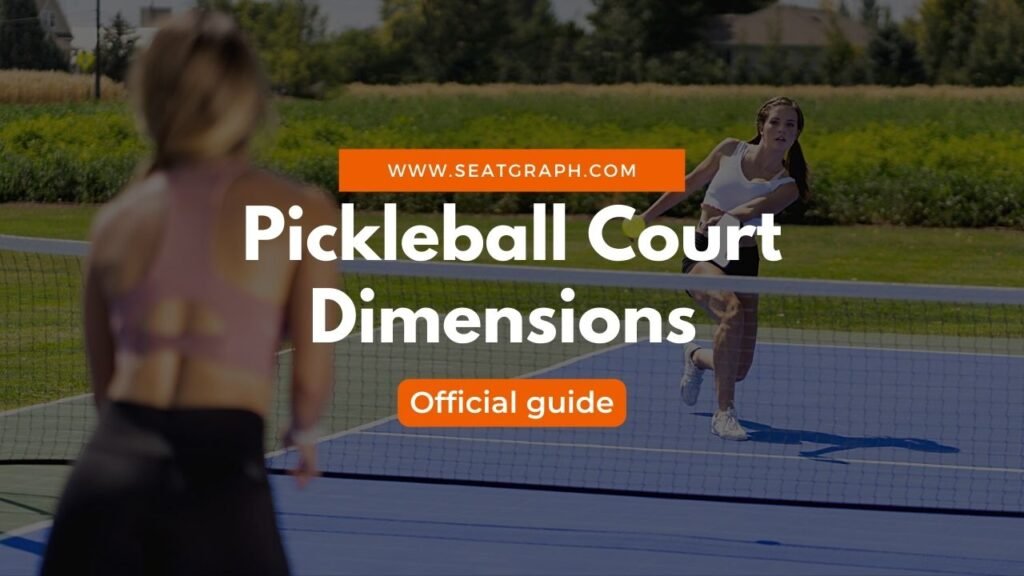Are you looking for the difference between pickleball court vs tennis court? You are at the right place. Pickleball and Tennis are popular recreational sports which share some similarities. Some of them are the use of a net and a ball.
There are also significant differences between the two sports. One of the main differences between pickleball and tennis is the size of the court.
In this blog post, I am going to compare and contrast pickleball court vs tennis court. We will explore the differences in court dimensions, surface type, and equipment used for both sports. By the end of this post, you will have a better understanding of which sport might be the best fit for you based on your preferences and skill level.
Size of Pickleball Court vs Tennis court
Size of a pickleball court is smaller than a tennis court. A standard pickleball court measures 20 feet wide by 44 feet long, while a standard tennis court measures 27 feet wide by 78 feet long for singles matches and 36 feet wide by 78 feet long for doubles matches.
A pickleball court is about one-third the size of a tennis court. Smaller pickleball court size requires less running and allows for longer rallies. This makes it a more accessible and popular option for players of all ages and skill levels.

Pickleball vs Tennis Comparision
Here is a comparison table between a pickleball court vs tennis court:
| Feature | Pickleball Court | Tennis Court (singles) | Tennis Court (doubles) |
|---|---|---|---|
| Court Dimensions | 20′ x 44′ | 27′ x 78′ | 36′ x 78′ |
| Net Height | 36″ | 3′ | 3′ |
| Ball | Wiffle Ball | Tennis Ball | Tennis Ball |
| Racket | Paddle | Tennis Racket | Tennis Racket |
| Scoring | Points to 11 | Points to 6, 7, or 8 | Points to 6, 7, or 8 |
| Serving | Underhand | Overhand or Underhand | Overhand or Underhand |
| Speed of Play | Slower | Faster | Faster |
| Court Surface | Hard or Soft | Hard or Clay | Hard or Clay |
| Number of Players | 2, or 4 (doubles) | 1 (singles) or 2, 4 | 2, 4 |
Pickleball Court Surface vs Tennis Court Surface
When it comes to court surfaces, both pickleball and tennis have a variety of options to choose from. Let’s take a look at some of the most common surface types used for both sports:
Concrete Surface
Concrete is a popular surface type for both pickleball and tennis courts. It is relatively low maintenance, durable, and provides a consistent bounce. However, concrete can be hard on players’ joints, making it more injury-prone compared to other surfaces.
Advantages: Low maintenance, durable, and provides a consistent bounce.
Disadvantages: Hard on players’ joints, more injury-prone compared to other surfaces.
Clay Surface
Clay is a common surface type for tennis courts, but it is not typically used for pickleball. It provides a slower game speed due to the ball’s decreased bounce, and it is also more slippery when wet. However, it is gentler on players’ joints, making it less injury-prone.
Advantages: Slower game speed, gentler on players’ joints.
Disadvantages: More slippery when wet, less consistent bounce.
Grass Court
Grass is commonly used for tennis courts, but it is not recommended for pickleball. It provides a fast game speed due to the ball’s quick bounce, but it is also more slippery when wet, making it more dangerous for players.
Advantages: Fast game speed, quick bounce.
Disadvantages: More slippery when wet, more dangerous for players.
Acrylic Surface
Acrylic is a common surface type for both pickleball and tennis courts. It is a low-maintenance surface that provides a consistent and medium-paced game speed. It is also gentler on players’ joints compared to concrete.
Advantages: Low maintenance, consistent and medium-paced game speed, gentler on players’ joints compared to concrete.
Disadvantages: None significant.
The surface type can affect the game speed, player mobility, and injury risk in various ways. For example, a faster surface like grass can result in quicker ball movement, requiring players to have quick reflexes and agility.
However, it can also be more dangerous if the surface is wet or if players slip. On the other hand, a slower surface like clay can provide a gentler game that’s less prone to injury, but it can also result in a slower ball speed that requires players to generate more power to hit their shots.
FAQs : Pickleball vs Tennis Court
Can a pickleball court be used for tennis?
Yes, a pickleball court can be used for tennis, but it’s not ideal. A pickleball court is much smaller than a tennis court, so the dimensions would not be regulation size for tennis. Additionally, the court surface and net height are different for both sports, which can affect the way the ball bounces and the overall gameplay experience.
How long does it take to build a pickleball or tennis court?
The time it takes to build a pickleball or tennis court depends on several factors, including the size of the court, the type of surface, and any local zoning or permitting requirements. Typically, building a pickleball court takes less time than building a tennis court, as pickleball courts are smaller and require less equipment.
Is it possible to play both sports on the same court?
Yes, it’s possible to play both sports on the same court, but it requires some modifications. To play both sports on the same court, the court would need to be regulation size for tennis, with a net height of 3 feet in the middle and 3.5 feet on the sides. The court would also need to be marked with additional lines for pickleball, including a kitchen area, service area, and non-volley zone.
Final Words
Comparison between pickleball court vs tennis court reveals significant differences in court size, surface type, etc. Pickleball courts are smaller, use different surface materials, and require specialized paddles and balls, while tennis courts are larger, use harder surfaces, and require larger rackets and balls.
For beginners and those looking for a more social and less physically demanding sport, pickleball might be the better option due to the smaller court size and lighter equipment. However, tennis might be more suitable for those seeking a more intense workout, with larger court dimensions and harder surface materials. Ultimately, it’s up to each individual to decide which sport suits their preferences and physical abilities best.
Regardless of the choice, both sports offer excellent opportunities for exercise, recreation, and socializing. I encourage you to try both sports and have fun playing them. Who knows? You might discover a new favorite pastime!
Also Read:



